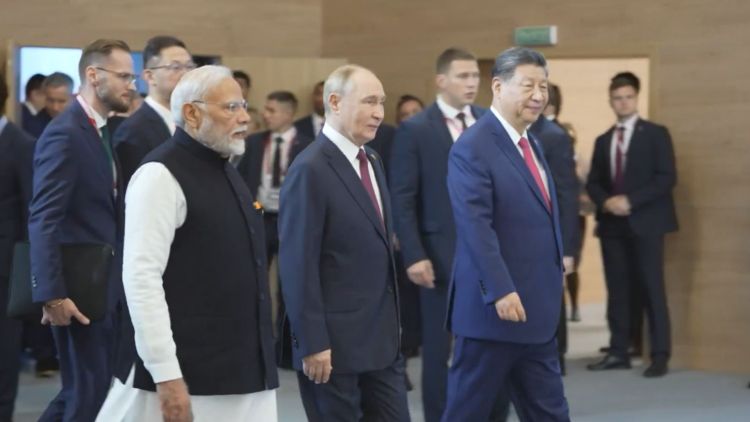The BRICS summit just wrapped up in Kazan, Russia, and it was quite a show. Held from October 22 to 24, the gathering saw Russian President Vladimir Putin rolling out the red carpet for some of the world’s most influential emerging economies.
With the group now expanded to include new members like Egypt, Ethiopia, Iran, and the United Arab Emirates (UAE), BRICS (Brazil, Russia, India, China, and South Africa) used this summit to signal that it’s serious about challenging Western dominance and reshaping the global order.
The timing couldn’t have been more interesting, coinciding with the fall meetings of the International Monetary Fund (IMF) and World Bank over in Washington.
While these traditional powerhouses talked about global economics, BRICS was busy pitching itself as the go-to alternative for countries fed up with the status quo. It was more than just a coincidence—it was a statement and one that sparked plenty of debate about whether BRICS can truly be a game-changer or if it’s just a club for those looking to thumb their noses at the West.
With members weighing in on issues like the Ukraine war and economic independence, the summit brought both optimism and some tough questions about the bloc’s future.
Let’s break down what happened and what it could mean going forward.
What Is BRICS?
BRICS, originally coined by Goldman Sachs economist Jim O’Neill in 2001, was a term used to describe emerging markets with significant growth potential: Brazil, Russia, India, and China. In 2011, South Africa joined the group, turning BRIC into BRICS.
The bloc has always been more than just an economic club. It represents a desire to challenge Western-led institutions and offer an alternative platform for countries seeking to exert their influence in global affairs.
The BRICS summit just wrapped up in Kazan, Russia, and it was quite a show. Held from October 22 to 24, the gathering saw Russian President Vladimir Putin rolling out the red carpet for some of the world’s most influential emerging economies.
With the group now expanded to include new members like Egypt, Ethiopia, Iran, and the United Arab Emirates (UAE), BRICS (Brazil, Russia, India, China, and South Africa) used this summit to signal that it’s serious about challenging Western dominance and reshaping the global order.
The timing couldn’t have been more interesting, coinciding with the fall meetings of the International Monetary Fund (IMF) and World Bank over in Washington.
While these traditional powerhouses talked about global economics, BRICS was busy pitching itself as the go-to alternative for countries fed up with the status quo. It was more than just a coincidence—it was a statement and one that sparked plenty of debate about whether BRICS can truly be a game-changer or if it’s just a club for those looking to thumb their noses at the West.
With members weighing in on issues like the Ukraine war and economic independence, the summit brought both optimism and some tough questions about the bloc’s future.
Let’s break down what happened and what it could mean going forward.
What Is BRICS?
BRICS, originally coined by Goldman Sachs economist Jim O’Neill in 2001, was a term used to describe emerging markets with significant growth potential: Brazil, Russia, India, and China. In 2011, South Africa joined the group, turning BRIC into BRICS.
The bloc has always been more than just an economic club. It represents a desire to challenge Western-led institutions and offer an alternative platform for countries seeking to exert their influence in global affairs.
The foreign ministers of the initial four BRIC states met in New York City in September 2006 on the sidelines of the UN General Assembly’s General Debate, marking the beginning of a series of high-level meetings. This diplomatic engagement laid the groundwork for a full-scale diplomatic meeting in Yekaterinburg, Russia, on June 16, 2009. These gatherings helped solidify the group’s framework for collaboration and laid the foundation for future expansion and institutional development.
The founding members of BRICS—Brazil, Russia, India, China, and South Africa—have long been seen as a counterbalance to the economic power wielded by Western countries. They aim to push back against what they perceive as the dominance of the US and Europe in shaping the global financial order.
Over the years, the group has expanded its scope with the recent addition of new members such as Egypt, Ethiopia, Iran, and the UAE. This expansion signals BRICS’ ambition to become a significant global player that isn’t limited by traditional Western alliances.
BRICS leaders at the Summit in Kazan, Russia. (Image grab via X)
Why Was BRICS Established?
The idea behind BRICS was not only to recognize the economic potential of these emerging markets but also to offer an alternative to Western-dominated institutions like the IMF and World Bank.
The group’s goal is to create a more balanced, multipolar world where the economic policies aren’t dictated solely by the US or Europe.
BRICS’ mission is to foster cooperation in areas like finance, energy, agriculture, and technology while providing a space for dialogue on political issues that often get sidelined by Western institutions.
Critics from the West often dismiss BRICS as an eclectic mix of countries with little in common beyond their desire to challenge Western hegemony.
It’s true that BRICS includes nations with different political systems and economic goals—from China’s centralized, state-driven economy to India’s democratic market-driven one.
Yet, despite these differences, there is a shared sense among BRICS members that the existing global order does not adequately serve their interests.
This sentiment resonates, especially in the Global South, where countries feel the effects of decisions made by Western institutions that often don’t prioritize their needs.
The Timing: An Alternative to the IMF and World Bank?
The timing of this year’s BRICS summit coincides with the IMF and World Bank meetings in Washington, bringing the contrast between the two groups into sharp focus.
While the IMF and World Bank are often criticized for their one-size-fits-all economic policies and stringent lending conditions, BRICS aims to present itself as a champion of economic sovereignty and a voice for developing nations.
Supporters argue that the IMF and World Bank have become out of touch with the needs of countries in the Global South.
Critics of these institutions point to their emphasis on austerity measures that often leave countries more indebted and economically vulnerable than before.
A recent report suggested that the IMF has drifted from its mission to support struggling economies, while the World Bank is seen as complacent in addressing global poverty, with rising poverty rates indicating that its efforts may be falling short.
BRICS, in contrast, promotes itself as offering a more cooperative approach. It’s about finding solutions that don’t come with the harsh conditions often associated with Western loans.
The new additions to the BRICS bloc, such as Iran and Ethiopia, are drawn to the idea of an alternative that doesn’t hinge on adopting Western economic policies.
However, skeptics question whether BRICS can genuinely provide a viable alternative.
While the idea of moving away from the US dollar as the dominant currency in international trade is appealing to many BRICS members, the reality is more complicated.
The dollar remains deeply entrenched in global finance, and efforts to replace it are easier said than done.
Additionally, there is a concern that if the Chinese renminbi becomes the leading alternative, BRICS could end up replacing one dominant power with another, swapping US influence for the Chinese.
Views on the War in Ukraine
The Ukraine conflict is one of the most contentious issues looming over this year’s summit.
While Russia seeks to use BRICS as a platform to strengthen its geopolitical position, some of its closest partners are calling for peace.
Ukrainian officials recently stated that Russia failed to gain support for its invasion at the BRICS summit, noting that the world majority continues to back Ukraine’s quest for comprehensive peace.
China’s President Xi Jinping made his stance clear, emphasizing the need to avoid escalation and calling for efforts to “ease the situation as soon as possible.” His comments reflected concerns about the conflict’s spillover effects on global stability.
Similarly, Brazilian President Luiz Inácio Lula da Silva urged for the start of peace negotiations, though he avoided direct criticism of Russia.
Indian Prime Minister Narendra Modi also called for peace through dialogue and diplomacy without mentioning Ukraine directly.
While these calls for peace don’t amount to direct opposition to Russia’s actions, they do highlight a divergence within BRICS on how to approach the conflict.
For Putin, this means balancing his narrative of military progress with the reality that even within this supposedly anti-Western bloc, there is not unanimous support for Russia’s military ambitions.
Is BRICS a Genuine Alternative or Just Anti-West?
The big question surrounding BRICS is whether it represents a true alternative to Western-led institutions or merely serves as a platform for countries dissatisfied with the current order.
The idea of “BRICS Plus,” which includes more countries from the Global South, certainly signals an intention to create a more inclusive platform.
Yet, the fundamental differences between member countries could also hinder the group’s ability to achieve meaningful reforms.
As one expert noted, “BRICS+ is only anti-West in that it operates as an alternative institution,” cited from CNBC News.
While there is a collective interest in achieving economic development that rivals the West, there is no guarantee that all member states will agree on what that development should look like.
For now, the unity within BRICS is driven more by shared grievances against Western economic practices than by a cohesive vision for the future.



